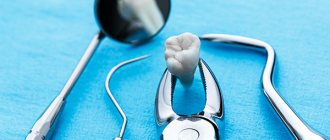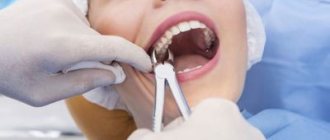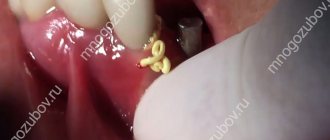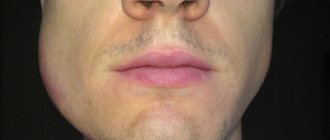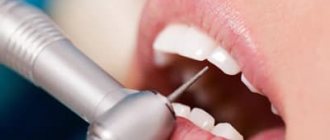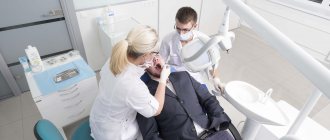In the last century, when asked whether it is painful to remove the root of a tooth if the crown is completely destroyed, many dentists would have given an affirmative answer. Pain during and after the procedure, complications from anesthesia and discomfort plagued many patients. But today the situation has changed - a diseased tooth and its root can be pulled out absolutely painlessly
.
Who will have to part with a tooth?
Complications following tooth extraction in the doctor's office are extremely rare. Much more often, sad consequences occur when it spontaneously falls out due to destruction or injury. In such cases, there are two options: restoration of dentin and enamel or removal of the tooth root.
The tooth root will have to be removed if the following symptoms occur:
- constant discomfort in the gums;
- sharp pain when chewing;
- swollen soft tissue;
- bleeding;
- the appearance of pus.
A sure sign of an inflammatory process in the gums is an increase in body temperature in the absence of symptoms of another disease.
Important! You cannot postpone a visit to the dentist, even if only one of these symptoms appears. Any suspicion that the tooth root remains in the gum and has begun to rot should prompt an urgent visit to a doctor.
What are the roots of teeth, look at the photo:
Temporary contraindications
Surgical removal of the root of a decayed tooth is contraindicated during:
- relapse of complex mental disorder;
- acute phase of ARVI;
- exacerbation of neurological disease;
- rehabilitation after a heart attack.
Doctors at dental clinics are aware of all contraindications to extraction. But not all conditions have clear clinical signs, so in order to avoid unpleasant consequences, it is necessary to warn the doctor about the ailment.
Why shouldn't you remove baby teeth yourself?
Removal of a baby tooth is considered premature if more than a year remains before a new one appears. This period is difficult to predict accurately, but you can roughly estimate it using a graph with average indicators.
Premature removal of a baby tooth is dangerous because its neighbors will try to take the vacant space. The roots of permanent teeth that are about to emerge will become crowded. The bite will change, which will take a long time to correct. Moreover, there are several strict contraindications for extracting baby teeth:
- Acute inflammatory diseases of the oral cavity.
- Inflammatory diseases of the throat (ARVI, sore throat, etc.).
- It is not recommended to remove teeth for pathologies of the cardiovascular system, kidneys, central nervous system, blood diseases, vitamin deficiency and nutritional dystrophy.
So when your child's first baby teeth start to loosen, don't disturb them and let them fall out naturally. The child's body knows its business.
When a tooth is already loose, it needs to be cleaned very carefully so as not to rush things. If your child is still in kindergarten and his motor skills are not well developed, help him: take ASEPTA® Baby dental wet wipes and wipe the tooth (as well as its neighbors) from the top and sides.
Generalized scheme for tooth extraction
The process of removing any tooth includes the following steps:
- Examination and collection of anamnesis (allergic status, information about the state of health and the dental apparatus).
- Preparation of the surgical field: treatment of the injection site, rinsing the mouth with an antiseptic.
- Anesthesia.
- Detachment of gum from tooth using a trowel.
- Loosening a tooth with forceps.
- Extracting a tooth from its socket.
- Treating the hole with an antiseptic.
- Stop bleeding with tamponade.
According to this scheme, simple removal is carried out. In some situations, for example, when a wisdom tooth or a badly damaged molar is pulled out, a complex extraction is required. Its main difference is that in addition to forceps, the dentist uses a drill to cut out bone tissue or saw the root into pieces, a chisel, a hammer and other dental instruments.
Wisdom tooth removal diagram
Getting rid of a wisdom tooth can be especially difficult. Due to its location in the posterior quadrant of the jaw, access to it is difficult. With anatomically incorrect or curved roots, which are often found in third molars, the dentist may be forced to make incisions in the gums, pull out the root piece by piece, and then apply sutures.
Treatment of pulpitis: review of modern treatment methods
When treating pulpitis, the most important task is to eliminate inflammation. For this purpose, conservative procedures or surgical methods that involve complete or partial removal of the pulp can be used. The doctor determines the type of treatment method for pulpitis individually for each patient, taking into account the form of the disease, as well as the stage of its development.
Conservative methods of treating pulpitis
If the patient does not self-medicate and at the first sign of pulpitis seeks professional medical help, then the disease can be treated using a conservative method and at the same time saving both the tooth and its nerve. The diseased tooth is drilled out so that the dentist has access to the pulp. It is treated with special antibacterial drugs and a medical gasket is placed on top, and the drilled tooth is closed with a temporary filling.
The patient will walk with the temporary filling for several days, after which he will return to the clinic for an X-ray. An image is taken to assess the quality of pulp treatment and if it shows that the inflammation has been stopped, the dentist will process the tooth canals, fill them and restore the tooth with a permanent filling.
USEFUL TO KNOW: Conservative methods of treating pulpitis will be effective if all procedures are carried out efficiently. Therefore, it is so important to choose the right dentistry for the treatment of pulpitis.
Surgical methods for treating pulpitis
The surgical treatment of pulpitis may involve either complete or partial removal of the dental nerve. The choice of a specific method depends on the stage of development of inflammation and is determined by the doctor after examining the patient and making a diagnosis. Most often, complete removal of the pulp is used: doctors are forced to make this choice for patients who came to the clinic for treatment of pulpitis too late, waiting for the inflammation to develop to a critical stage.
Complete pulp removal can be:
- Vital. This method involves extracting the dental nerve under anesthesia. To do this, the tooth is drilled with a drill, and all dental tissue affected by caries is removed. The drilled cavity is treated with an antiseptic and then the dentist, using a special tool, removes the pulp, and then fills the canals and tooth. This method is considered universal and suitable for the treatment of various forms of pulpitis, but it cannot be used for patients with allergies to anesthetic drugs;
- Devital. When choosing this pulp removal technology, the dental nerve is first exposed to toxic substances, which are placed in the form of a paste into the tooth cavity for up to 2 days. After the specified time has passed, the patient returns to the clinic, where the dentist removes the dead dental nerve from the tooth, treats the canals and places a permanent filling on the tooth.
This method of treating pulpitis is highly effective, but cannot be used in cases of purulent form of the disease or severe tissue necrosis.
Sometimes amputation is used as a method of treating pulpitis, which involves removing only part of the dental nerve. This method is not applicable for teeth with only one root, since in this case the dentist is not able to accurately identify individual parts of the dental nerve. Amputation is usually performed in the treatment of acute pulpitis.
How is a decayed tooth removed?
The process of tooth extraction is a simple dental operation. The difficulty increases when you need to remove the root of a tooth that is completely destroyed. Factors requiring the intervention of an experienced specialist:
- small size of the remaining crown;
- condition of surrounding tissues;
- the location of the remaining hard tooth tissues under the upper edge of the gums;
- defects of gums, roots.
Affects the complexity of the operation and whether the position of the upper or lower jaw belongs. In the upper jaw, the walls of the sockets are longer and thicker; accordingly, teeth are removed from them with great difficulty - a highly qualified dentist is required to perform the manipulation.
Wisdom teeth, from which only the root remains, are removed in the same way as ordinary molars, but in some patients, healing after such an intervention is very painful.
Examination and preparation
The procedure begins with a thorough examination and preparation of the patient. When you first visit the clinic, the doctor will take an x-ray and examine the oral cavity.
Doctor's tasks:
- determine the condition of the tooth, assess the extent of destruction;
- clarify the presence of allergies, contraindications, inflammation;
- choose a method of pain relief;
- draw up an operation plan;
- prepare tools.
The tools used to remove a rotten tooth root are a drill, forceps, and a set of elevators (photo).
A prerequisite is hygienic treatment of adjacent tissues. Extraction is possible only after removing stones and plaque from the molars, incisors or canines surrounding the surgical field. Immediately before extraction, the oral cavity is treated with a Chlorhexidine solution.
Anesthesia
There are cases when dentin is destroyed gradually, without inflammation, without the appearance of rot. In such situations, painless root removal is possible without the use of painkillers, however, anesthesia is more often necessary.
The choice of drug is carried out taking into account:
- age;
- allergic status;
- presence of somatic diseases;
- individual intolerance to drugs;
- presence of chronic diseases: epilepsy, diabetes;
- complexity of the upcoming operation.
The patient must notify the dentist about any deviations before the procedure begins. In most cases, the tooth root is removed under local anesthesia - one or two injections for incisors, 2 to 4 injections into the gums for molars. But if two teeth are destroyed, or the jaw is to be opened, the patient receives general anesthesia - he will sleep until the doctor finishes pulling out the tooth.
Features of pain relief for a tooth with a rotten root
An anesthetic injection is given at the site of the projection of the tooth roots. But if the medicine is injected into the rotten area, it may not work and the person will be hurt during the extraction process.
Treatment of patients with rotten roots is carried out in two stages. On the first visit, the dentist numbs the gum, prepares it and cleans it of pus. During the second visit, anesthesia is repeated, and the doctor removes the root that has rotted inside the gum.
Removal
The doctor decides how to remove a tooth if only the root remains. Usually they start with the use of forceps. Even if the destroyed roots remain under the gum, the holes do not completely heal - the dentist can carefully pick up the remnants of hard tissue and easily pull them out.
If the tooth has crumbled to the very base, it is pulled out with an elevator. Having inserted the instrument between the gum and dentin, the doctor presses on the handle and makes rotational movements of small amplitude. As a result, the periodontal fibers shift and the root is squeezed out of the socket.
A drill is used when it is necessary to crush the hard tissues of a molar before removal. With proper anesthesia, this procedure is painless; discomfort is possible only when the gums are already healing.
Relieving inflammation
When removing a rotten root, an inflammatory process is often detected. To ensure that the wound heals safely and does not fester, it is customary to treat it with an antiseptic. But one treatment will not provide adequate prevention, so an anti-inflammatory drug is placed in a fresh hole. With it, the hole will heal faster, and the patient will have less chance of developing alveolitis.
Stitching
To extract the root system, the doctor separates and lifts flaps of soft tissue; they can only be attached back by suturing. It is customary to tighten the edges of the holes with threads during double or triple removal, when a significant part of the gum has been subjected to preparation. This is done so that the affected area heals faster and does not cause discomfort to the patient.
What does the sensation of pain depend on?
How painful it is to pull teeth, according to research, depends on several factors. In the same patient, the intensity of pain during extraction may vary depending on the following signs:
- a molar or baby tooth needs to be pulled out - removal of a baby molar is almost painless, since it does not have powerful long roots, like those of a permanent one;
- location on the jaw arch - frontal molars are removed with a feeling of much less intense pain, since they are smaller in size, their root system is not as developed as that of the lateral teeth. The same can be said about trauma to the surrounding soft tissues - they suffer less, especially in comparison with wisdom tooth extraction;
- tooth shape and number of roots - by nature, human molars can have 1-2 or 3-4 branches of a stabilizing root system. So, tooth extraction will be more uncomfortable the more root branches the molar has.
It is necessary to clarify that whether it is painful to pull out a tooth depends not only on the listed factors, but also on the perception of the procedure by the person himself. If you experience a feeling of panic and intense fear before the extraction, this psychological state can directly affect the procedure and actually provoke intense pain. There are many stories among patients not only about how much pain is felt during extraction, but also that there is a big difference whether a molar is removed from above or below, supposedly this affects the intensity of the discomfort.
We need to figure out whether these rumors have a scientific basis. Dentists claim that, regardless of the location of the tooth, it can be removed completely painlessly if high-quality anesthesia is administered, but the jaw may begin to hurt after the end of the freezing period. The severity of the pain syndrome will depend on several points:
- how much bone and soft tissue was destroyed;
- is there an acute inflammatory process at the time of removal;
- a frontal or lateral tooth is subjected to extraction;
- the lower or upper molar is removed;
- whether there is an accumulation of pus in the area of the unit being removed.
According to medical statistics, the removal of the upper incisors is less painful, since their root system is not as powerful and tortuous as that of the lower teeth.
The fact that lower units are more difficult to remove from the bed is also due to the density of the bone tissue. All these factors directly affect the degree of destruction and recovery time after the molar has been removed. Therefore, it makes no sense to say that it is painful to remove the lower teeth, but not the upper ones; the location will only affect the adaptation period after extraction.
If there are root fragments left in the hole
If the wound edges were tightened with catgut, the patient’s treatment can be considered complete. If a non-absorbable material was used, the patient will have to return to the dentist to have the sutures removed after a week. During this time, it is necessary to monitor the condition of the gums, your own sensations and notify the doctor if:
- the operated areas constantly hurt;
- throbbing pain is felt.
This means that small fragments of tooth tissue, which may have gone unnoticed during extraction, rot in the hole. The doctor must prescribe a repeat X-ray for the patient, check the quality of the operation and find out the cause of the ailment. Inaction is fraught with the development of alveolitis (inflammation of the socket), osteomyelitis, phlegmon and other serious diseases.
How to remove a rotten tooth root while preserving the crown
A tooth in which only the root remains is not always pulled out entirely. For example, if an inflammatory process develops at the root apex, but the tooth itself can still be saved, resection of the root apex is performed - partial removal.
The procedure is carried out after filling the canals, under local anesthesia. The operation is simple and lasts no more than half an hour. Its main stages:
- Anamnesis collection.
- Preparation of the surgical field.
- Anesthesia.
- Cutting the gum to access the root.
- Delamination of soft tissues.
- Sawing out a “window” in the bone.
- Cutting off the inflamed area of the root with a granuloma or cyst.
- Placing drugs into the cavity that stimulate bone growth.
- Stitching.
What to do after deletion
After any surgical intervention, you should follow all the dentist’s recommendations, as well as:
- do not eat for 2 hours after the procedure;
- cool the soft tissues of the face in the projection of the removed root;
- stop smoking for two days;
- take prescribed pain medication;
- make antiseptic applications;
- watch to see if other teeth are crumbling.
Sometimes after complex extractions, dentists prescribe antibiotics to patients.
This appointment cannot be ignored - after a tooth is pulled out of the socket, a focus of infection forms in it, which can only be extinguished with the help of medications.
The following video schematically shows different methods for removing incisors, canines, molars and premolars of the lower and upper jaw.
When do baby teeth start falling out?
During the first three years of life, a child grows 20 baby teeth. At this time, a temporary bite is formed: it is distinguished by a pronounced anatomical shape, thin enamel, and susceptibility to caries. After the first three years, the roots of baby teeth slowly dissolve, making room for a permanent bite. From the age of 4-5 years, baby teeth begin to fall out, and this continues until the fifth or sixth grade of school.
In most cases, the process occurs calmly and does not require third-party intervention, including medical attention. Dentists strongly advise against rushing things.
